Reflections on SSO#11 – Sound System Cultures Worldwide
SSO#11 – Sound System Cultures Worldwide (7-8 November, 2025) was the final research symposium held during the course of the SST project. Unlike previous SSO events —which either brought practitioners and researchers into dialogue or placed practitioners centre stage— SSO#11 was designed to provide all SST contributing researchers with the opportunity to showcase their work, as well as the London premiere of many of the project’s documentaries. The two-day event was not only a chance to highlight the many achievements of the SST project but also an opportunity to reflect in depth on its implications, legacies, and possible futures. London-based author and long-time SSO associate David Katz has compiled a detailed account of these two days of talks, film screenings, discussions, and sound system sessions held at Goldsmiths, University of London.
By David Katz
Photos by Anta Male
Held at the Professor Stuart Hall Building at Goldsmiths on 7 and 8 November 2025, the eleventh edition of Sound System Outernational was a triumph that evidenced the broad scope of the Sonic Street Technologies project and the dynamic interface between academic theory and the firsthand experiences of practitioners. Utilizing a hybrid format that enabled those unable to travel to London to join in the conversation from afar (seamlessly enabled by team member Suifan Adey), SSO#11 offered two marathon days of presentations, film screenings and lively conversations diving deeper into the sound system scenes that have evolved across five continents and their attendant cultural and historical specificities; it flagged state repression, appropriation and divisions of race, class, gender and sexual orientation as amongst the many elements that impact the form in complex ways, the ongoing innovations of devoted practitioners helping sound systems to move forward in a caustic era of disappearing venues, high unemployment and far-Right hostility. Having the Soul Rockers sound system of Tuscany, Italy, in residence in the foyer throughout the proceedings reminded that the sound system is still a living, breathing entity that continues to evolve and their hosting of the dance at the end of the event highlighted that the form is as much a source of joy as of cultural resistance.

Conference room filling up in the morning
On Friday morning, Professor Julian Henriques opened the event by reminding everyone of the relationship between SSO and SST—namely, that Sound System Outernational began in 2016 at the instigation of Dr. Leonardo Vidigal and Dr. Brian D’Aquino, who were then undertaking postdoctoral and doctoral studies with Julian at Goldsmiths. Entirely unfunded, the SSO team began staging academic symposia and sound system events off their own backs to acknowledge the importance of the culture, and as the project evolved space was made for sound system practitioners to get in their own two-cents worth, as demonstrated at SSO#5, staged in Naples in 2019. Then, Sonic Street Technologies is the ERC-funded project that has been running for the last five years and will draw to a close at the end of December 2025. The grant has helped ensure that sound system culture receives greater acknowledgment in academia, while also enabling a more in-depth and far-reaching investigation capable of unpacking its nuances and implications.
As part of the introduction, Julian emphasised that the film screenings would be a highlight of SSO#11, most having been made in situ by sound system practitioners in diverse locations, illuminating local and global significances. He also reminded that the entire event was livicated to June Reid of Nzinga Soundz, a longstanding practitioner who was in the midst of exploring the culture for her MA at Goldsmiths before tragically succumbing to fatal health issues, aged 67.
In his opening address, Dr. Brian D’Aquino pointed out that the winding up of SST does not signal the end of the research; on the contrary, the outputs of SST will remain online for at least the next ten years, including the Sonic Map and the SST Video Archive, where most of the research interviews will be made available. He also announced the Mobile Music Machine (MMM) book series as the main academic output of the project, with the current publishing schedule including four edited volumes, the first of which is expected to see the light of day in 2026. In parallel with the MMM book series publication, Sound System Outernational is set to continue the work through new symposia, investigations, and events.
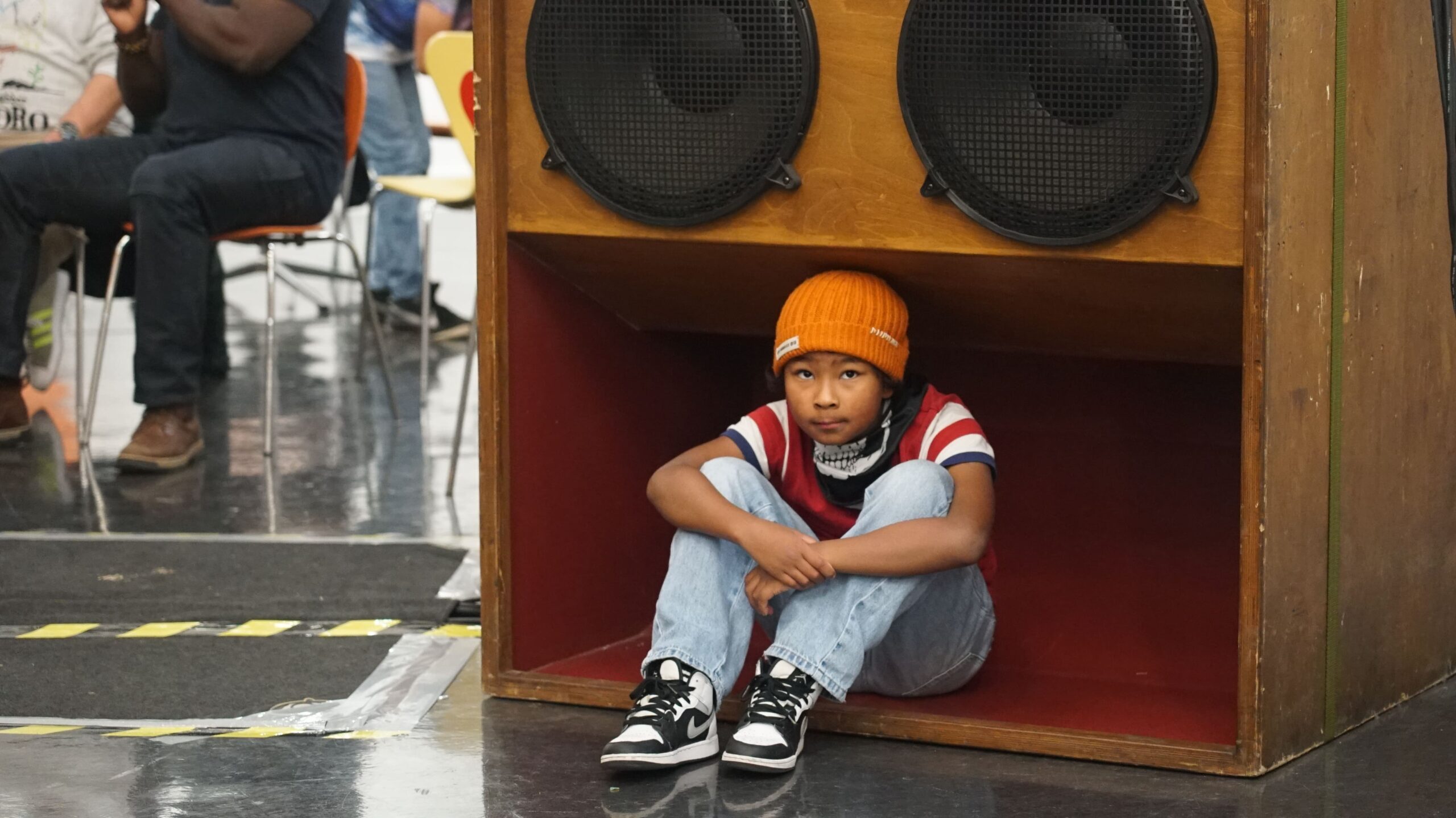
A young participant
The first panel, entitled Global Resonances, brought us halfway round the world to Australia, where researchers from the University of Sydney helped us to better understand the sound system scenes that have blossomed there during the last decade. Dr Clare Cooper began by giving some crucial background context to the unique contributions of sound system culture across the land; a map helped us to understand the vast distances between cities with distinctive scenes, as well as the 17,000 kilometre gulf between the nation and Jamaica; the film From Powerful Origins: A Honey Trap Sound System Story by Maia Dal Berger profiled an all-female bass music sound system collective based in a peripheral Sydney suburb, challenging the male dominance of the form and making space for their own cathartic dance music expressions.
In another helpful contextual presentation, Dr Moses Iten – currently based in Tasmania but present at Goldsmiths in person – unpacked the history of sound system culture in Australia through a focus on the Heavy Congress event, which saw Melbourne’s ten top sound systems all playing together in 2022, despite little overlap in terms of genre, physical construction and approach. The film Heavy! A Congress of Sound Systems in Melbourne/Naarm by Francesco Vincenzi brought the significance of the event into greater focus, interviews with practitioners such as Adrian Wall and Heartical Hi Powa underlining important distinctions and local genealogies.
Former Swamp Jockeys/Youthu Yindi member Dr Andrew Belletty then shifted focus to his native Darwin, the northern former frontier outpost that has suffered from high levels of youth crime and hostile policing. As shown in the film Knock ‘Em Down Sound System, after an absence of 20 years, Andrew returned to implement what he termed a ‘minor intervention’ based around an environmentally friendly sound system, staging workshops and events with young people to introduce alternatives to the prevalent nihilism and social exclusion that leads to violent crime.
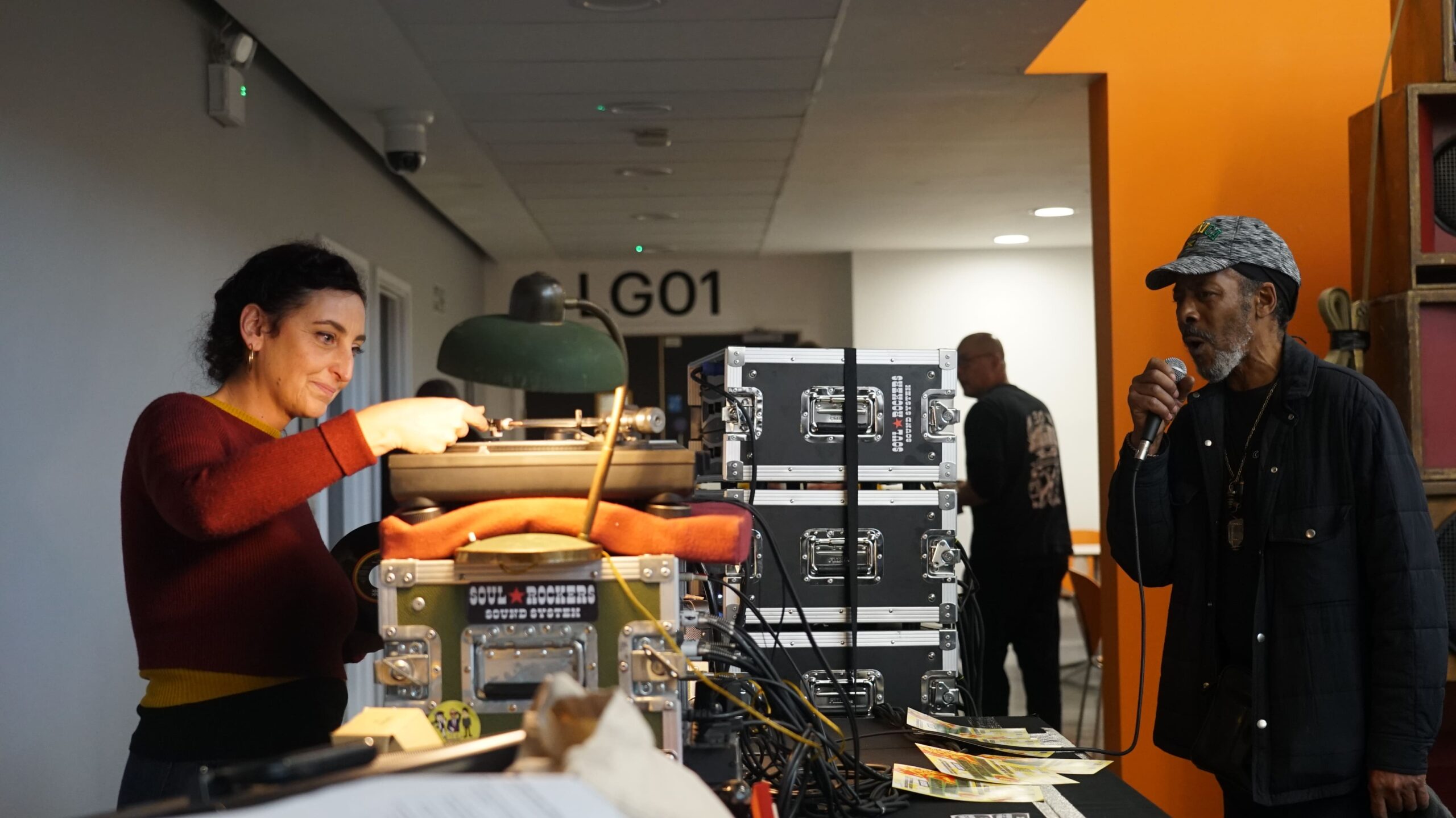
Soul Rose from Soul Rockers sound system and MC Doc Murdoc setting the vibe
After the coffee break, the Global Resonances panel continued with longstanding SST associate Dr Aadita Chaudhury of the University of York in Canada. She began her session on sound systems in India by screening the Bass Foundation Roots film by Ankur Tanwar, profiling the crowd-funded, politically-active BFR sound system launched by Taru Dalmia and Samara Chopra of the band Ska Vengers in New Delhi after their disillusionment with the constraints of band sponsorship and nightclub life. Aadita then detailed the complexities of the scenes that have sprung up in diverse Indian cities during the last decade, pointing to the differences between Small Axe sound, formed by a street artist in the far northeast, and Monkey sound system, launched by a high-caste Brahmin in Hyderabad, as well as the pioneering 10,000 Lions, built in Goa by a Swede and an Italian in 2015.
To conclude the first panel, Dr Jean-Christophe Sevin of the University of Avignon talked us through the challenges facing tekno sound systems in France, specifically regarding the hostile policing targeting the free party scene since the early 1990s. Noting that tekno sounds were harder to reach research-wise than reggae sound systems due in part to mistrust of the authorities and institutions, Jean-Christophe highlighted that the current punitive measures curtailing sound system expression in France are similar to those enacted in Italy under Giorgia Meloni’s government.

Serving Caribbean lunch during the conference break
Once our bellies were full with the wholesome Caribbean lunch provided, the afternoon sessions transferred us to Latin America and its diasporic communities in the USA. I learned a lot from the Colombia panel, which was thought-provoking, inspiring and harrowing in equal measure. Brian’s introduction reminded that the nation is vast, with a complex and fraught colonial history that led to a tortured post-colonial phase punctuated by armed conflict, with paramilitary forces, clandestine narcotrafficking and state oppression negatively impacting human rights. In terms of its rich sound system culture, he emphasised the role of indigenous Colombian sound systems, the picós, whether in their traditional form, known as turbos, or with the more modern fraccionados, who spice up their music with added synthesizers, samplers and drum machines.
Independent researcher Edgar Benitez Fuentes provided some context on how the more traditional picó scene of Colombia’s Caribbean coastal cities migrated to the capital, Bogotá, where a growing reggae and dub sound system scene has also been emerging over the past decade, adapting the technological and musical influences of the British and European scenes to the local context. The film Sonido, Palabra y Poder (Sound, Word and Power) got to the heart of the situation in the capital by focussing on El Gran Latido, the best-known reggae and dub sound system in the land, whose sessions are part of their political activism, pushing back against police oppression and the discrimination meted out to women and those of indigenous or African descent, the film unfolding against a backdrop of nationwide strikes sparked by proposed pension cuts in 2019.

Prof Sonjah Stanley Niaah of UWI Mona, Jamaica
Continuing with the Colombia strain of the research, Jorge Giraldo Barbosa helped us to unpick two of Cartagena’s most legendary super-picós, namely El Imperio and El Rey de Rocha, his presentation helpfully detailing some of the form’s rich local history and its significant evolution since the 1930s and 40s through the lenses of the technological capital which stands at the heart of their practice. Then, independent researchers and community activists Miladis Cordoba Rivas and William Albornoz Quejada brought us to the contested borderland region of Urabá in northwest Colombia, where the picotera culture evolved in unique ways, due in part to the region’s isolation and the historical specificities of the place. The film Sonando con Proposito (Playing with Purpose) by Ricardo Vega highlighted that the African Colombian and indigenous population of Urabá faces challenges relating to captured land and the proliferation of both paramilitary and guerrilla groups, which at their worst attacked a picó event, destroying the sound system by fire and killing some 35 attendees. Thankfully, since 2021 the sound system collective in Urabá led by Miladis and Willinton has aimed to use the picó as a means of fostering unity in an area blighted by terrifying divisions and wanton violence, with a variant of 90s dancehall the music of choice. Involving much more than just the unifying power of music, their ethos of ‘playing with purpose’ evidently covers a wide range of activities aimed at local betterment, such as engaging in social work with young mothers, supporting the poor, cleaning up the streets and providing a safe space for former gang members who have renounced violence.
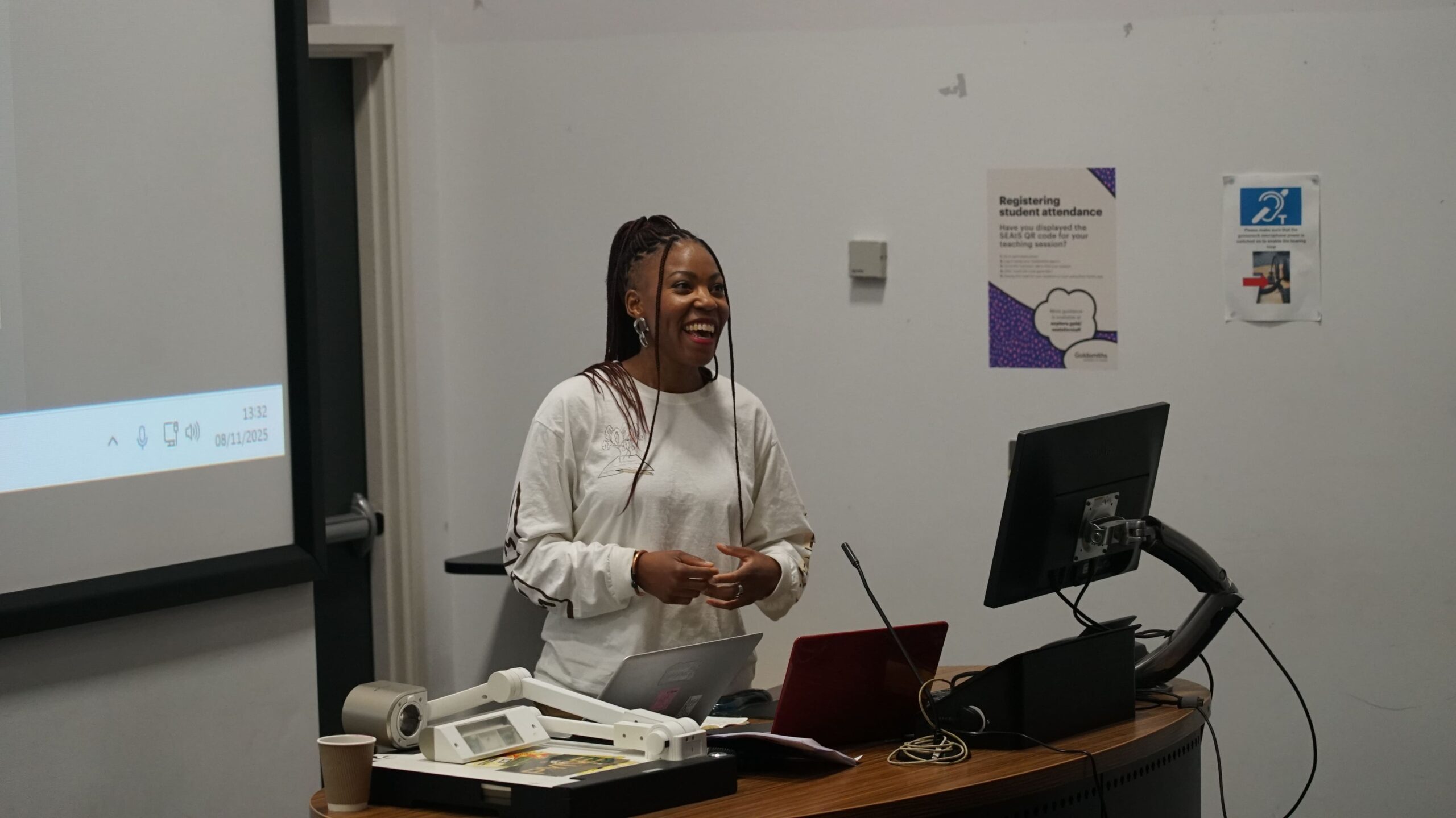
Presenter Alanna Stuart of Queens University Ontario
Moving to Mexico and the Mexican diaspora in the United States, PhD candidates Fernanda Cruz and Paulina Lanz at the University of Southern California delved into the complex realities of the Musas Sonideras USA, a group of female sonideras active in various American cities, part of a broader network of female practitioners that spans some 20 Latin American countries, as well as the USA. In their presentation, Fernanda introduced different layers that define the practice of the Musas, positing that their testimonies at the microphone act as a kind of witnessing and that the voice is the primary technology they employ. It was also emphasised that the sonideras typically play in small nightclubs or in family-friendly restaurants, unlike the street settings often used by their male counterparts. The importance of the on-mic shout-outs was highlighted, allowing instantaneous connection to fans on both sides of the border via internet chat platforms; a focus on the voice and a feminist technical theory were the hallmarks of the research, with Fernanda and Paulina acting as witnesses more than anything else. The Musas USA film by Francisco Tejeda brought everything into focus, illuminating the different personalities behind the mics and the challenges they face in striving for recognition in a male-dominated field; as an out lesbian, La Mamichiz potentially faced further ostracism, but was obviously revered in the spaces in which she performed, regardless of the composition of the audiences.
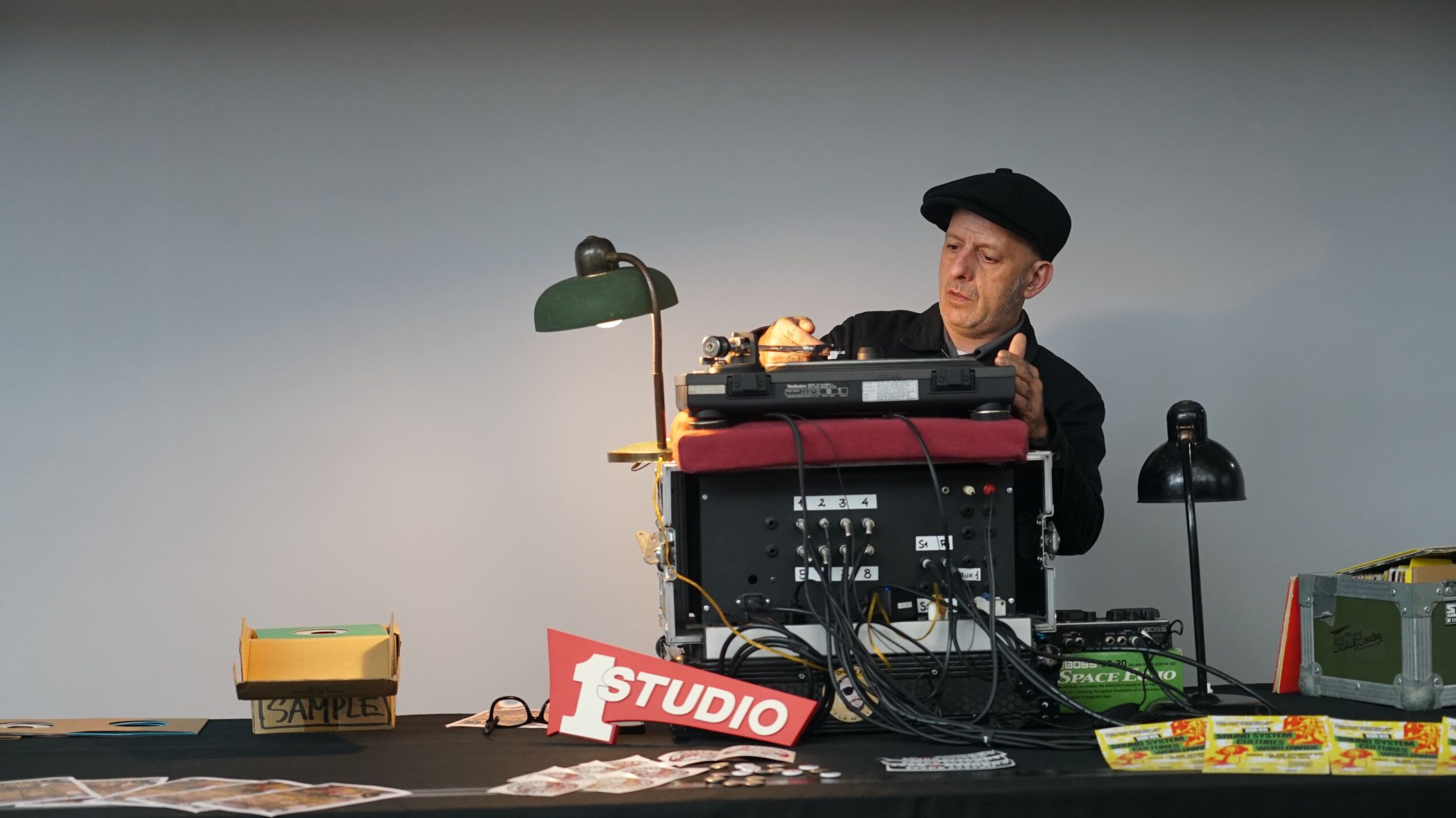
Francesco aka Scratching Sounds from Soul Rockers sound system testing the single deck
Rounding off day one, Dr Cesar Rebolledo of the Univerity of La Salle in Mexico City introduced the concept of Puebla York, the Big Apple as the grounding point for a massive Mexican diaspora. He reminded that the sonidero is not merely a DJ in such a setting, but is instead a cultural mediator between past and present, old country and new world. His film El Sonido de los Suenos (The Sound of Dreams) explored the tales of transplanted migrants who became sonideros in New York, including a man who crossed the Rio Grande with nothing more than a change of clothing and three cumbia mixtapes. This touching and at times heartbreaking film helped us to understand that the music they played evoked nostalgia for a time and place that no longer exists, even as it was helping the protagonists to forge new identities in their adopted host country.
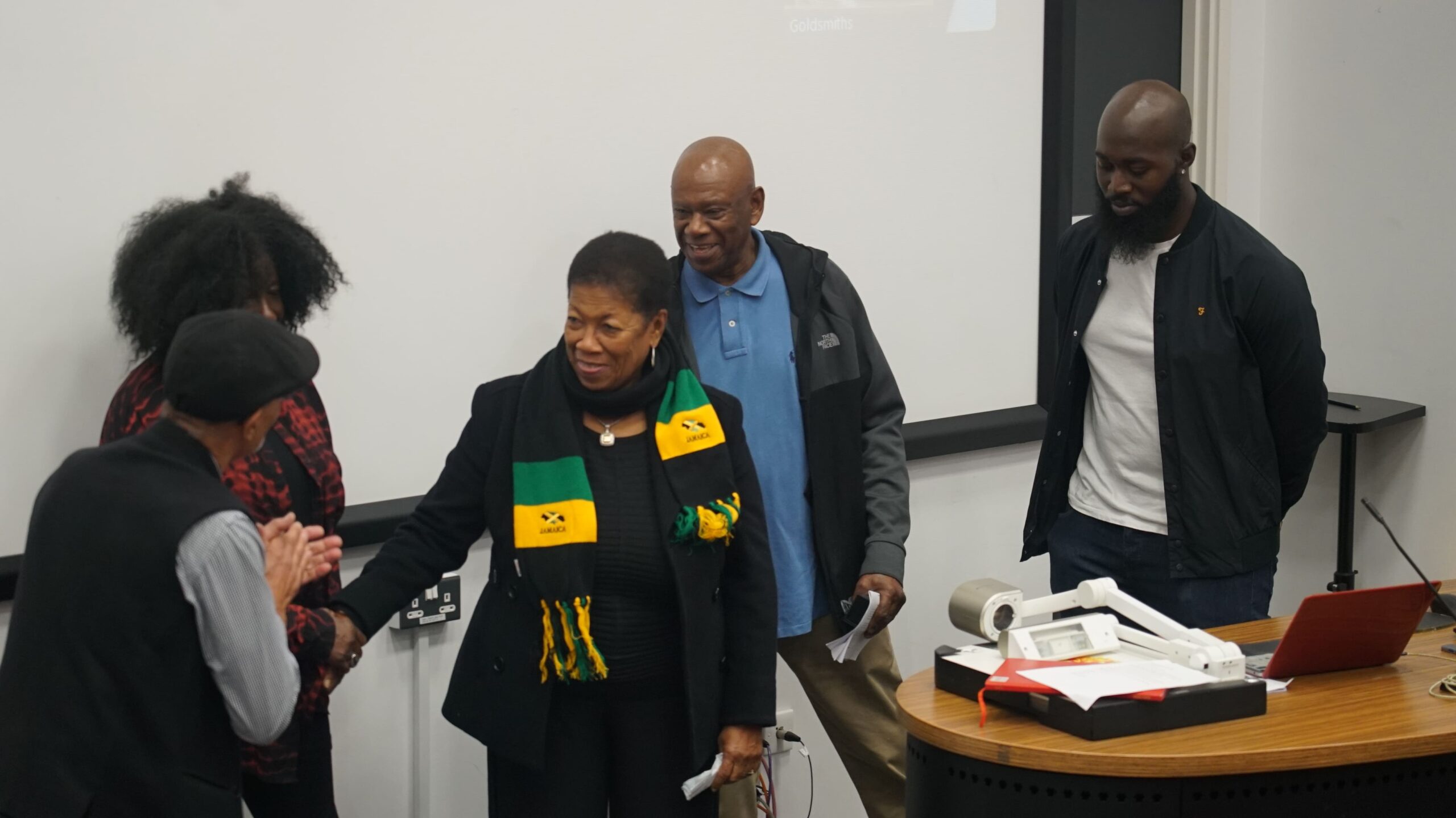
The late June Reid’s family joining the livication, L to R: Julian Henriques, Lynda Rosenior-Patten (Nzinga Soundz), Eileen “Bibs” Young (June’s sister), Beresford “BT” Genus (June’s brother), Jelani Reid (June’s son)
On Saturday morning, we got off to an inevitably late start and it was touching to have June Reid’s sister and son on hand to say a few words about her, along with her close friend and partner on the decks, Lynda Rosenior-Patten of Nzinga Soundz. Then, after a brief introduction, Sonjah Stanley Niaah of the University of the West Indies Mona campus, opened the Jamaica strand with a detailed presentation on the evolution of sound system technology on the island during the last nine decades, highlighting the groundbreaking work of pioneers such as Hedley Jones. The film Sounds of the Future: A Jamaican Sound System Industry Reasoning Session was comprised of edited highlights of an unprecedented gathering of veteran Jamaican sound system personnel undertaking a roundtable discussion chaired by Sonjah and her colleague Dr Dennis Howard, and the audience responded well to the material, the obvious camaraderie, witty jokes and salient points offered by the legends giving much food for thought.
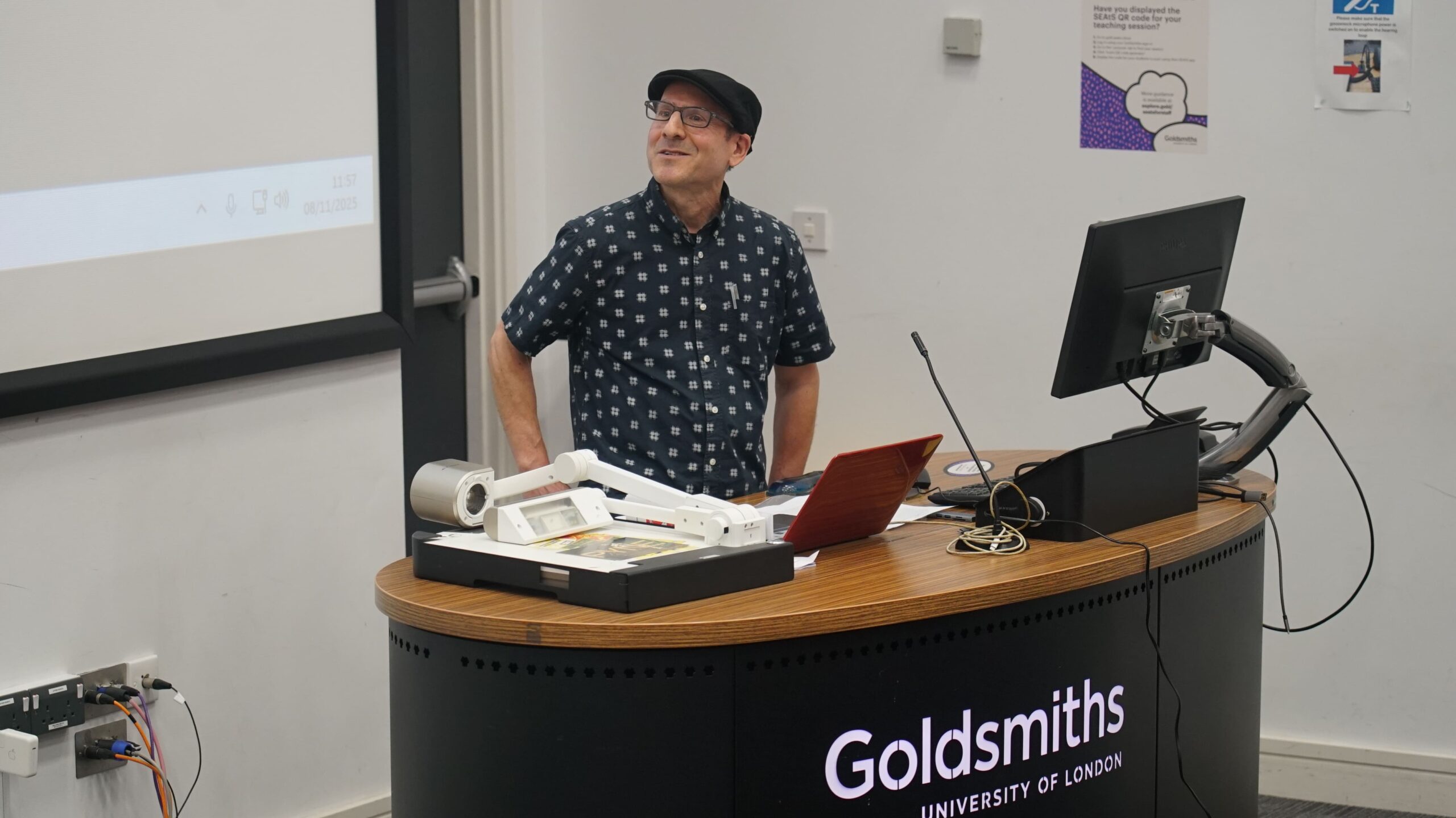
David Katz introducing ‘Rockers Sound Station’
Before our screening of Rockers Sound Station: Tales of the Kingston Dub Club, I did my best to explain how Gabre Selassie faced years of struggle to establish the Kingston Dub Club as a viable entity, enduring a decade of instability before moving it to his home in the hills above Kingston at the suggestion of revered reggae artist Luciano, where it has since become the preeminent space for roots reggae and dub music in Jamaica. I also pointed out that the film began organically as an unintended consequence of the pandemic, when SSO was pushed to the virtual sphere.
Moving to the Jamaican diaspora in Canada, PhD candidate Alanna Stuart of Queens University Ontario began her exploration of queer and female-led sound systems in Toronto with an imagistic short film profiling her maiden voyage to Jamaica, questioning whether she would be accepted by the sound system fraternity as a non-Jamaican born queer black woman of mixed Caribbean heritage. Her theoretical presentation that followed introduced the complexities of her ‘femmehall’ movement, which aims to promote the presence of women in dancehall’s production and diffusion, by focussing on the experiences of five female selectors active in Toronto’s bass music scene.

Audience listening to the panel discussion
Shifting to the north of England, the independent researchers and longstanding SST collaborators Mandeep Samra and Gopal Dutta explored the sound system scene of 1980s Huddersfield, drawing on research conducted in 2013-14 and 2021-22. Mandeep emphasised that the early work uncovered a largely hidden history and Gopal detailed the importance of a prominent sound system venue on Venn Street, in the heart of the city, which regularly attracted attendees from all over the north. Then we were back in Canada for a fascinating presentation by Prof Mark Campbell of the University of Toronto, detailing the long, complex and largely undocumented history of sound system culture in Toronto and Montreal, which spoke to successive waves of Jamaican immigration; I eagerly await the publication of Mark’s research and am hoping that a book will be the eventual outcome.
After lunch, the Sounds of Brazil panel gave us lots of pertinent and thought-provoking information about that country’s diverse sound system scenes. Dr Bruno Barbosa Muniz offered chilling insights on the historical defiance and ongoing stigmatisation of Rio’s baile funk scene, while Dr Marcus Ramúsyo de Almeida Brasil of the Federal University of Maranhão used the writings of Walter Benjamin and Aby Warburg to trace tenuous links between sound system culture and traditional folk practices in northeast Brazil and Jamaica. Natalia Figueredo of the University of Barcelona and Dr Maria Luisa de Barros of the University of São Paulo got down to the intriguing nitty gritty of the distinctive aparelhagens of Belem, an industrial city in the Amazon basin with a peculiar sound system scene centred on massive sets with complex lighting systems, highlighting as well the emergence of the new treme dance moves prevalent in Belem.
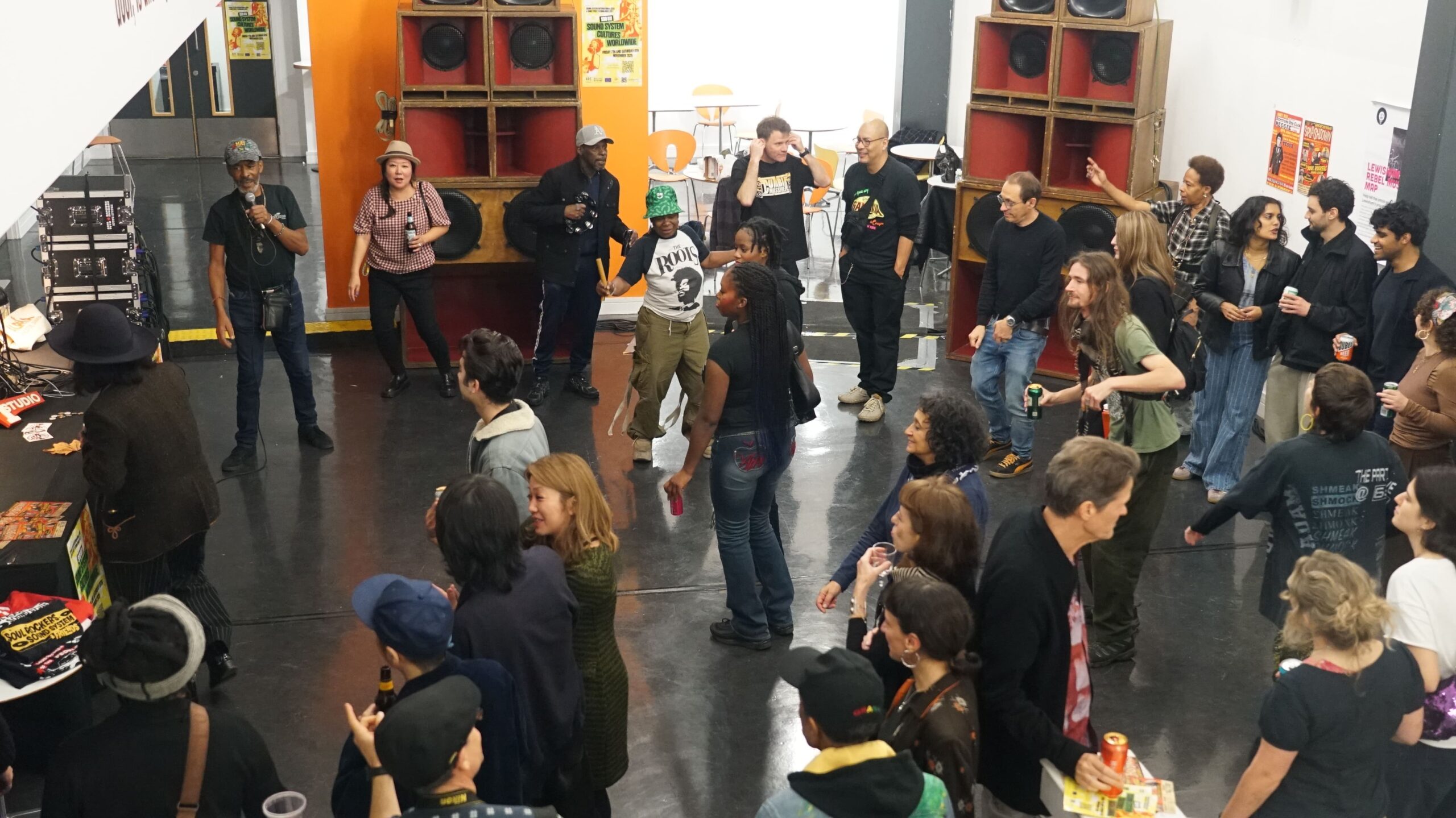
Post-conference session with Soul Rockers sound system
Confirming both the vastness of Brazil and the richness of its sound system culture, the panel continued with a presentation from Gisela Castro of ESPM São Paulo and Roberto Gonzaga of the University of São Paulo, who used the work of Deleuze and Guattari, Stuart Hall and Brandon LaBelle to dissect the phenomenon of DZ7, a collective based in the Paraisópolis favela of São Paulo that hosts massive baile funk parties. Finally, Marcelo Yokoi of the University of São Paulo gave an overview of São Paulo’s sound system scene, homing in on the importance of Feminine Hi-Fi who rose up to challenge the peripheral status accorded to black female selectors, and then independent researcher Dani Pimenta, formerly of Feminine Hi-Fi, gave an introduction to the short film that profiled the journey, detailing their rise from the underground dancehall scene to the many community events they spearheaded in Brazil and further bouts of female empowerment brokered through annual tours of Europe.
The closing statement by Julian gave thanks to the team for their work over the last five years and reminded again that a series of Mobile Music Machines books are forthcoming, drawing on research outputs. He also reminded us that the SST research project made clear that sound system culture is often given little value by the Global South bourgeoisie and the academic establishment alike, yet this hugely enriching project has shown just how important this culture is to countless people globally. Themes of technology, culture and embodiment were constants throughout SSO#11 which ultimately underlined that diverse practitioners around the world are using sound system technology to fight against oppression and to join communities closer together. Hats off to Sonic Street Technologies for a most riveting and enlightening Sound System Outernational gathering – looking forward to the future iterations and more good things to come.
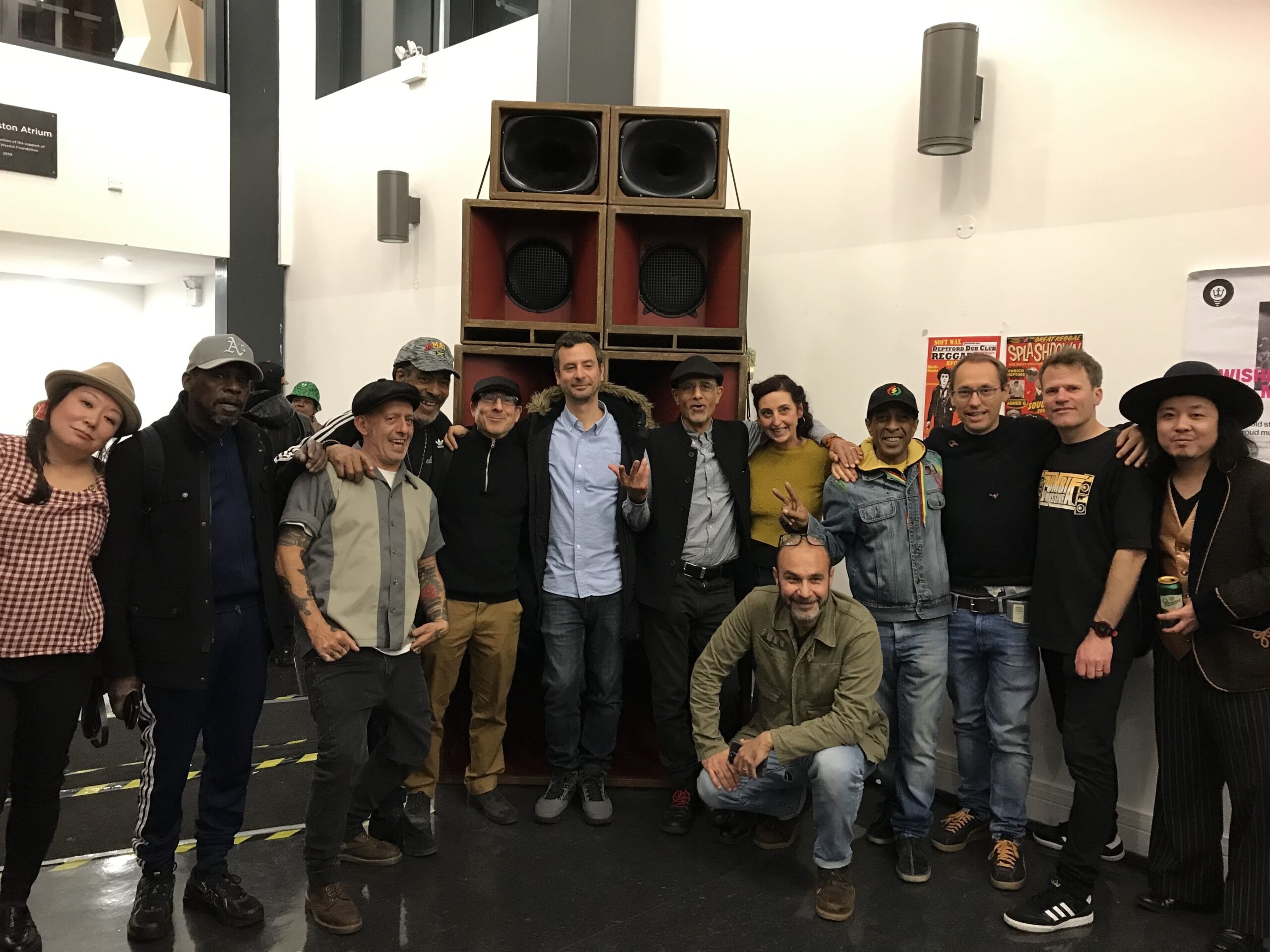
SSO#11 group picture, including some of the organisers, presenters, sound system crew and guest selectors
About the Author:
David Katz is the author of People Funny Boy: The Genius of Lee ‘Scratch’ Perry and Solid Foundation: An Oral History of Reggae. Visit him at www.davidkatzreggae.com
